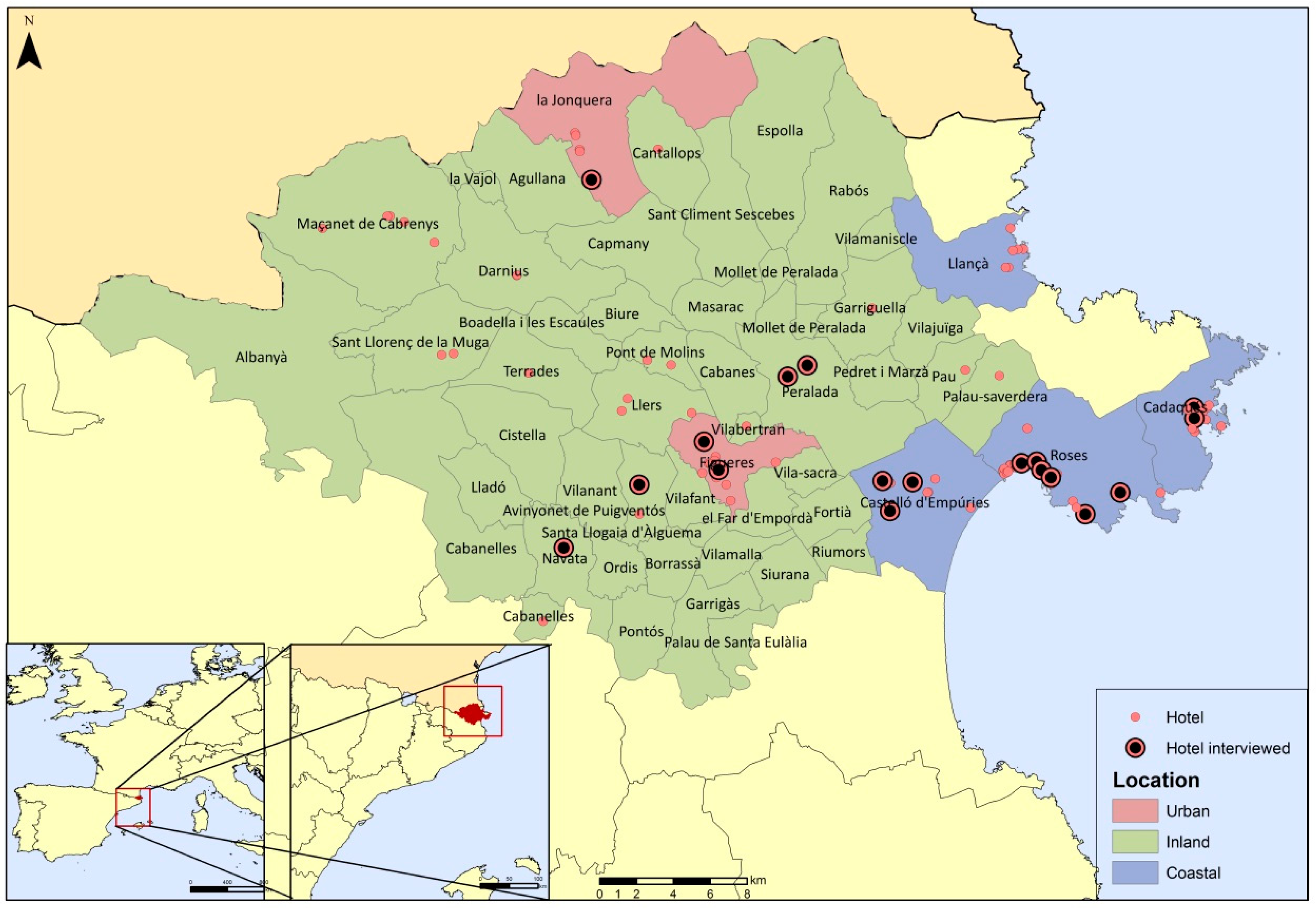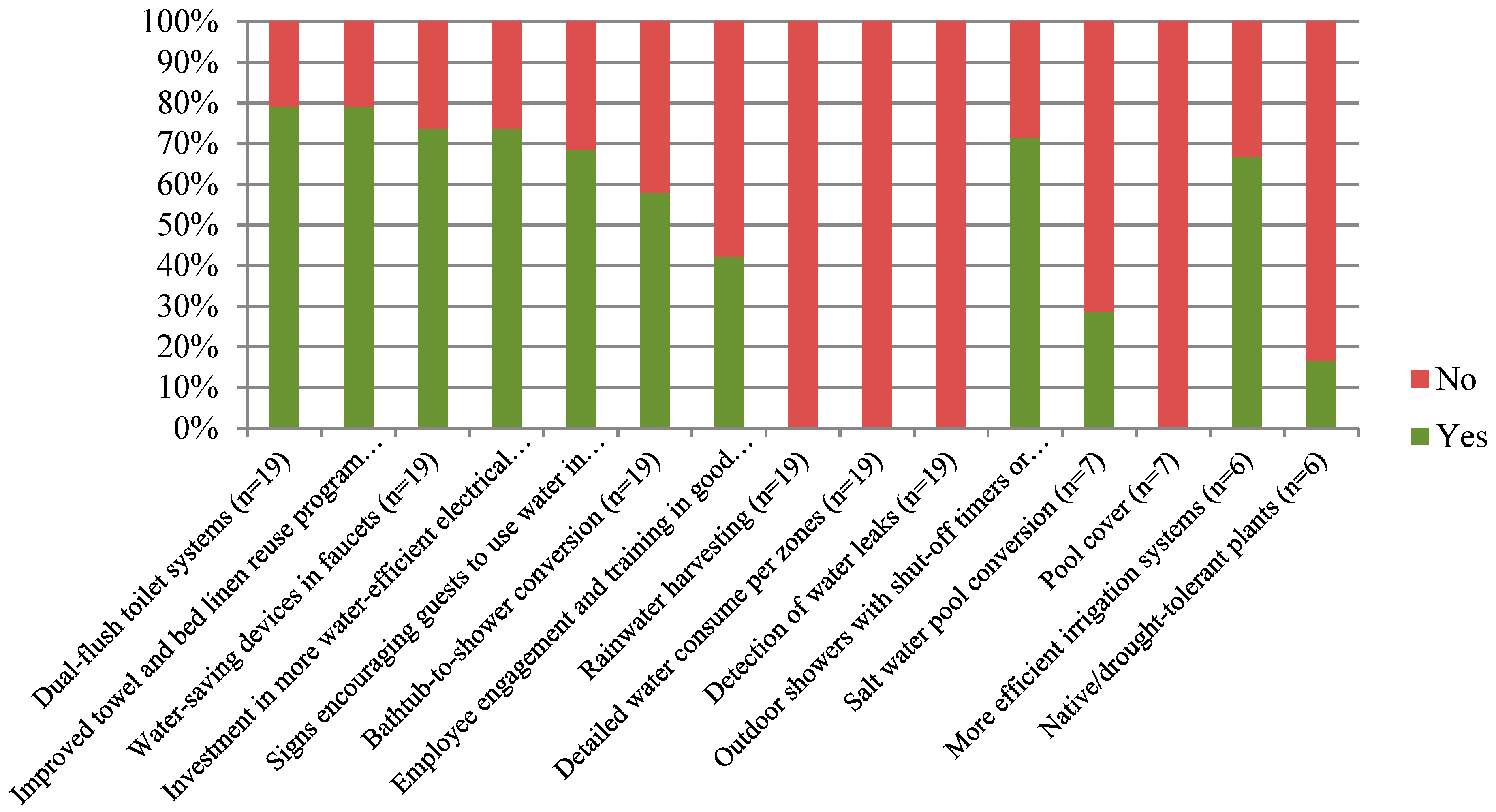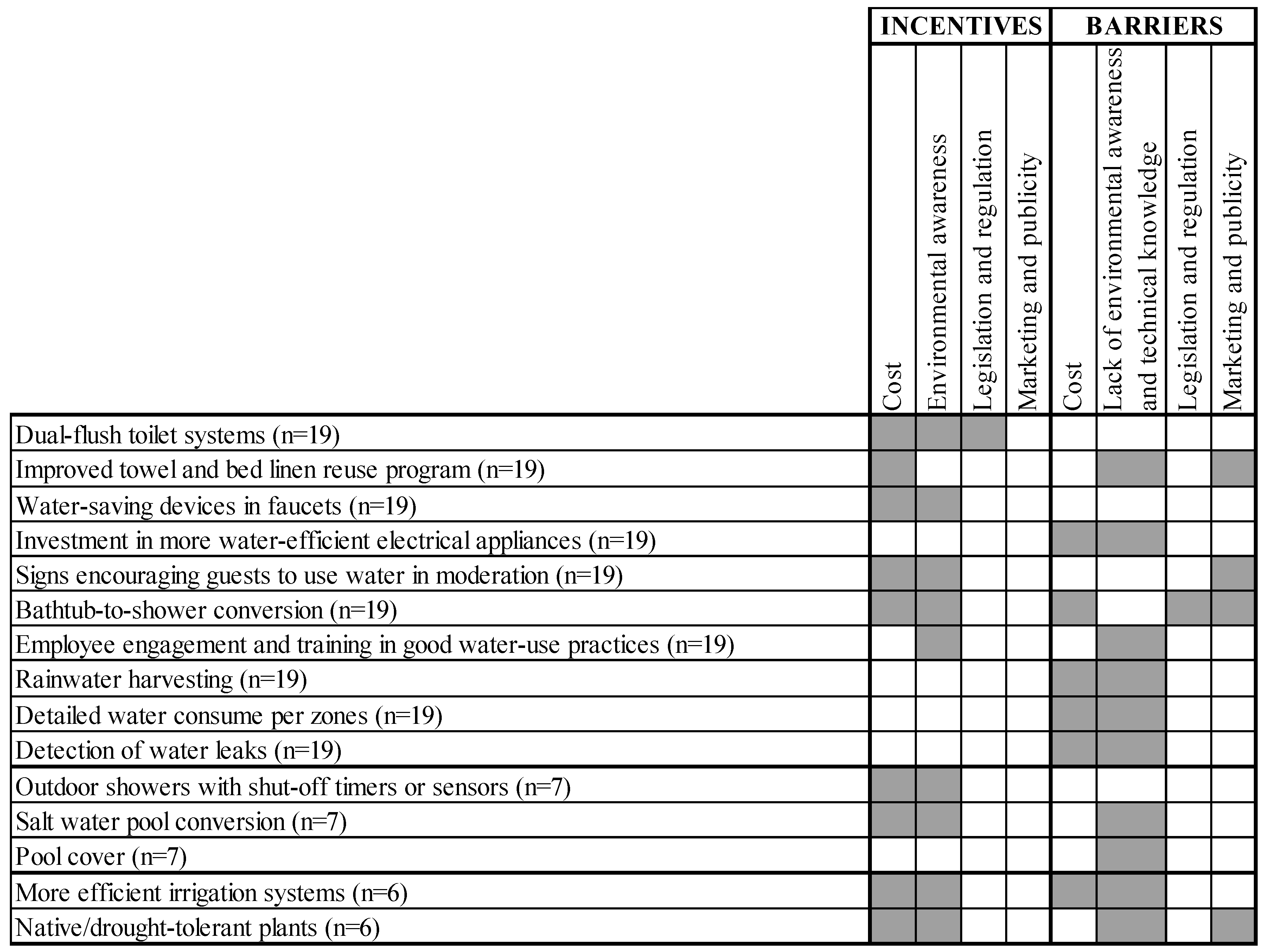Incentives and Barriers to Water-Saving Measures in Hotels in the Mediterranean: A Case Study of the Muga River Basin (Girona, Spain)
Abstract
1. Introduction
2. Theoretical Framework
3. Study Area
4. Methodology
5. Results
5.1. Implementation of Water-Saving Measures
5.2. Incentives, Barriers, and Perceived Responsibilities
6. Discussion
7. Conclusions
Author Contributions
Funding
Conflicts of Interest
References
- Morrison, C.; Pickering, C.M. Perceptions of climate change impacts, adaptation and limits to adaption in the Australian Alps: The ski-tourism industry and key stakeholders. J. Sustain. Tour. 2013, 21, 173–191. [Google Scholar] [CrossRef]
- Gössling, S.; Peeters, P. Assessing tourism’s global environmental impact 1900–2050. J. Sustain. Tour. 2015, 23, 639–659. [Google Scholar] [CrossRef]
- Köberl, J.; Prettenthaler, F.; Bird, D.N. Modelling climate change impacts on tourism demand: A comparative study from Sardinia (Italy) and Cap Bon (Tunisia). Sci. Total Environ. 2016, 543, 1039–1053. [Google Scholar] [CrossRef] [PubMed]
- Alonso, A.D. How Australian Hospitality Operations View Water Consumption and Water Conservation: An Exploratory Study. J. Hosp. Leis. Mark. 2008, 17, 354–372. [Google Scholar] [CrossRef]
- Emmanuel, K.; Spence, B. Climate change implications for water resource management in Caribbean tourism. Worldw. Hosp. Tour. Themes 2009, 1, 252–268. [Google Scholar] [CrossRef]
- Gössling, S.; Peeters, P.; Hall, C.M.; Ceron, J.; Dubois, G.; Vergne, L.; Scott, D. Tourism and water use: Supply, demand, and security. An international review. Tour. Manag. 2012, 33, 1–15. [Google Scholar] [CrossRef]
- Gössling, S.; Hall, C.M. Tourism and Water; Channel View: Texas, TX, USA, 2015. [Google Scholar]
- Deyà, B.; Tirado, D. Hotel water consumption at a seasonal mass tourist destination. The case of the island of Mallorca. J. Environ. Manag. 2011, 92, 2568–2579. [Google Scholar] [CrossRef] [PubMed]
- Rutty, M.; Scott, D. Will the Mediterranean become “Too Hot” for tourism? A reassessment. Tour. Hosp. Plan. Dev. 2010, 7, 267–281. [Google Scholar] [CrossRef]
- Roson, R.; Sartori, M. Climate change, tourism and water resources in the Mediterranean A general equilibrium analysis. Int. J. Clim. Chang. Strateg. Manag. 2014, 6, 212–228. [Google Scholar] [CrossRef]
- Klontza, E.E.; Kampragkou, E.; Ververidis, K.; Papadopoulou, M.P.; Lekkas, D.F. Evaluation of water saving measures for mid-sized tourist lodging units: The case of Samos Island, Greece. Eur. J. Environ. Sci. 2016, 6, 37–42. [Google Scholar] [CrossRef][Green Version]
- Kelly, J.; Williams, P. Tourism destination water management strategies: An eco-efficiency modelling approach. Leisure/Loisir 2007, 31, 427–452. [Google Scholar] [CrossRef]
- Olcina Cantos, J. Turismo y cambio climático: Una actividad vulnerable que debe adaptarse. Investig. Turísticas 2012, 4, 1–34. [Google Scholar] [CrossRef]
- Kaján, E.; Saarinen, J. Tourism, climate change and adaptation: A review. Curr. Issues Tour. 2013, 16, 167–195. [Google Scholar] [CrossRef]
- Pascual, D.; Zabalza Martínez, J.; Funes, I.; Vicente-Serrano, S.M.; Pla, E.; Aranda, X.; Savé, R.; Biel, C. Impacts of Climate and Global Change on the Environmental, Hydrological and Agricultura Systems in the LIFE MEDACC Case Study Basins. 2016. Available online: http://medacc-life.eu/sites/medacc-life.eu/files/docuemnts/d14_quantificationimpacts_v4.pdf (accessed on 4 March 2019).
- Generalitat de Catalunya. Third Report on Climate Change in Catalonia. 2016. Available online: http://cads.gencat.cat/web/.content/Documents/Publicacions/tercer-informe-sobre-canvi-climatic-catalunya/Sintesis/CC_Sintesi_ANGLES_web.pdf (accessed on 4 March 2019).
- Torres-Bagur, M.; Ribas, A.; Vila-Subirós, J. Perceptions of climate change and water availability in the Mediterranean tourist sector: A case study ofthe Muga river basin (Girona, Spain). Int. J. Clim. Chang. Strateg. Manag. 2019. [Google Scholar] [CrossRef]
- Gabarda-Mallorquí, A.; Ribas Palom, A. Understanding reductions in water consumption in tourist areas: A case study of the Costa Brava, Spain. Int. J. Water Resour. Dev. 2016, 32, 916–934. [Google Scholar] [CrossRef]
- Diputació de Girona XIFRA—Sistema Informació Socieconòmica Local. Available online: http://www.ddgi.cat/xifra/provincials/activecon/tur_enq_campings.asp?IdMenu=03030804 (accessed on 6 August 2018).
- Pavón, D.; Gabarda-Mallorquí, A.; Ribas, A. What governance? The role of public and private stakeholders in water supply management in Mediterranean coastal tourist destinations: The case of the Costa Brava. Water 2018, 10, 1758. [Google Scholar] [CrossRef]
- Ventura Pujolar, M.; Ribas Palom, A.; Saurí Pujol, D. Gestión del agua y conflictividad social en la cuenca del río Muga (Alt Empordà). Geographicalia 2000, 38, 59–75. [Google Scholar]
- Bayés, C.; Ribas, A.; Saurí, D. Sequías y prensa regional en la cuenca del río Muga (Girona). Geographicalia 2003, 44, 113–144. [Google Scholar]
- Ribas, A.; Saurí, D. 2008, l’any de la sequera. Anu. Territ. Catalunya, 2008. 2010. Available online: http://www.territori.scot.cat/cat/viewer.php?IDN=1504 (accessed on 6 June 2019).
- Deng, S.; Burnett, J. Water use in hotels in Hong Kong. Int. J. Hosp. Manag. 2002, 21, 57–66. [Google Scholar] [CrossRef]
- Angulo, A.; Atwi, M.; Barberán, R.; Mur, J. Economic analysis of the water demand in hotels and restaurants sector: Shadow prices and elasticities. Water Resour. Res. 2014, 50, 6577–6591. [Google Scholar] [CrossRef]
- Ayuso, S. Adoption of voluntary environmental tools for sustainable tourism: Analysing the experience of Spanish hotels. Corp. Soc. Responsib. Environ. Manag. 2006, 13, 207–220. [Google Scholar] [CrossRef]
- Claver-Cortés, E.; Molina-Azorín, J.F.; Pereira-Moliner, J.; López-Gamero, D. Environmental strategies and their impact on hotel performance. J. Sustain. Tour. 2007, 15, 663–679. [Google Scholar] [CrossRef]
- Hadjikakou, M.; Miller, G.; Chenoweth, J.; Druckman, A.; Zoumides, C. A comprehensive framework for comparing water use intensity across different tourist types. J. Sustain. Tour. 2015, 23, 1445–1467. [Google Scholar] [CrossRef]
- Bohdanowicz, P. Environmental awareness and initiatives in the Swedish and Polish hotel industries-survey results. Int. J. Hosp. Manag. 2006, 25, 662–682. [Google Scholar] [CrossRef]
- Tekken, V.; Kropp, J.P. Sustainable water management—Perspectives for tourism development in north-eastern Morocco. Tour. Manag. Perspect. 2015, 16, 325–334. [Google Scholar] [CrossRef]
- Han, H.; Hyun, S.S. What influences water conservation and towel reuse practices of hotel guests? Tour. Manag. 2018, 64, 87–97. [Google Scholar] [CrossRef]
- Lee, J.; Hsu, L.J.; Han, H.; Kim, Y. Understanding how consumers view green hotels: How a hotel’ s green image can influence behavioural intentions. J. Sustain. Tour. 2010, 18, 901–914. [Google Scholar] [CrossRef]
- Manaktola, K.; Jauhari, V. Exploring consumer attitude and behaviour towards green practices in the lodging industry in India. Int. J. Contemp. Hosp. Manag. 2007, 19, 364–377. [Google Scholar] [CrossRef]
- Chan, E.S.W.; Okumus, F.; Chan, W. The applications of environmental technologies in hotels. J. Hosp. Mark. Manag. 2017, 26, 23–47. [Google Scholar] [CrossRef]
- Choi, G.; Parsa, H.G.; Sigala, M.; Putrevu, S. Consumers’ environmental concerns and behaviors in the lodging industry: A comparison between Greece and the United States. J. Qual. Assur. Hosp. Tour. 2009, 10, 93–112. [Google Scholar] [CrossRef]
- Chan, E.S.W. Barriers to EMS in the hotel industry. Int. J. Hosp. Manag. 2008, 27, 187–196. [Google Scholar] [CrossRef]
- Bohdanowicz, P. European hoteliers’ environmental attitudes: Greening the business. Cornell Hotel Restaur. Adm. Q. 2005, 46, 188–204. [Google Scholar] [CrossRef]
- McLennan, C.; Becken, S.; Stinso, K. A Water Use Model for the tourism industry in the Asia-Pacific Region: The impact of water saving measures on water use. J. Hosp. Tour. Res. 2014, 41, 746–767. [Google Scholar] [CrossRef]
- Olcina Cantos, J.; Baños Castiñeira, C.J.; Rico Amorós, A.M. Medidas de adaptación al riesgo de sequía en el sector hotelero de Benidorm (Alicante, España). Rev. Geogr. Norte Gd. 2016, 65, 129–153. [Google Scholar] [CrossRef]
- Charara, N.; Cashman, A.; Bonnell, R.; Gehr, R. Water use efficiency in the hotel sector of Barbados. J. Sustain. Tour. 2011, 19, 231–245. [Google Scholar] [CrossRef]
- Warren, C.; Becken, S. Saving energy and water in tourist accommodation: A systematic literature review (1987–2015). Int. J. Tour. Res. 2017, 19, 289–303. [Google Scholar] [CrossRef]
- Gabarda-Mallorquí, A.; Garcia, X.; Ribas, A. Mass tourism and water efficiency in the hotel industry: A case study. Int. J. Hosp. Manag. 2017, 61, 82–93. [Google Scholar] [CrossRef]
- Rico, A.; Olcina, J.; Baños, C.; Garcia, X.; Sauri, D. Declining water consumption in the hotel industry of mass tourism resorts: Contrasting evidence for Benidorm, Spain. Curr. Issues Tour. 2019. [Google Scholar] [CrossRef]
- Kasim, A. Managerial attitudes towards environmental management among small and medium hotels in Kuala Lumpur. J. Sustain. Tour. 2009, 17, 709–725. [Google Scholar] [CrossRef]
- Bohdanowicz, P.; Martinac, I. Determinants and benchmarking of resource consumption in hotels-Case study of Hilton International and Scandic in Europe. Energy Build. 2007, 39, 82–95. [Google Scholar] [CrossRef]
- Alonso, A.D.; Ogle, A. Tourism and hospitality small and medium enterprises and environmental sustainability. Manag. Res. Rev. 2010, 33, 818–826. [Google Scholar] [CrossRef]
- Page, S.J.; Essex, S.; Causevic, S. Tourist attitudes towards water use in the developing world: A comparative analysis. Tour. Manag. Perspect. 2014, 10, 57–67. [Google Scholar] [CrossRef]
- Dinarès, M.; Saurí, D. Water consumption patterns of hotels and their response to droughts and public concerns regarding water conservation: The case of the Barcelona hotel industry during the 2007–2008 episode. Doc. D’anàl. Geogr. 2015, 61, 623–649. [Google Scholar] [CrossRef]
- Bruns-Smith, A.; Choy, V.; Chong, H.; Verma, R. Environmental Sustainability in the Hospitality Industry: Best Practices, Guest Participation, and Customer Satisfaction. 2015. Available online: https://scholarship.sha.cornell.edu/chrpubs/196/ (accessed on 2 April 2019).
- Gössling, S. The consequences of tourism for sustainable water use on a tropical island: Zanzibar, Tanzania. J. Environ. Manag. 2001, 61, 179–191. [Google Scholar] [CrossRef] [PubMed]
- Stabler, M.J.; Goodall, B. Environmental awareness, action and performance in the Guernsey hospitality sector. Tour. Manag. 1997, 18, 19–33. [Google Scholar] [CrossRef]
- Bramwell, B.; Alletorp, L. Attitudes in the Danish tourism industry to the roles of business and government in sustainable tourism. Int. J. Tour. Res. 2001, 3, 91–103. [Google Scholar] [CrossRef]
- Vernon, J.; Essex, S.; Pinder, D.; Curry, K. The “greening” of tourism micro-business: Outcomes of focus group investigations in south east Cornwall. Bus. Strateg. Environ. 2003, 12, 49–69. [Google Scholar] [CrossRef]
- Chan, E.S.W. Implementing environmental management systems in small- and medium-sized hotels: Obstacles. J. Hosp. Tour. Res. 2011, 35, 3–23. [Google Scholar] [CrossRef]
- Ayuso, S. Comparing voluntary policy instruments for sustainable tourism: The experience of the Spanish hotel sector. J. Sustain. Tour. 2007, 15, 144–159. [Google Scholar] [CrossRef]
- Garay, L.; Font, X. Doing good to do well? Corporate social responsibility reasons, practices and impacts in small and medium accommodation enterprises. Int. J. Hosp. Manag. 2012, 31, 329–337. [Google Scholar] [CrossRef]
- Cole, S. Tourism and water: From stakeholders to rights holders, and what tourism businesses need to do. J. Sustain. Tour. 2014, 22, 89–106. [Google Scholar] [CrossRef]
- Cole, S. A political ecology of water equity and tourism. A case study from Bali. Ann. Tour. Res. 2012, 39, 1221–1241. [Google Scholar] [CrossRef]
- Post, J.; Altman, B.W. Managing the Environmental Change Process: Barriers and Opportunities. J. Organ. Chang. Manag. 1994, 7, 64–81. [Google Scholar] [CrossRef]
- Berry, S.; Ladkin, A. Sustainable tourism: A regional perspective. Tour. Manag. 1997, 18, 433–440. [Google Scholar] [CrossRef]
- Hjalager, A.-M. Environmental regulation of tourism: Impact on business innovation. Prog. Tour. Hosp. Res. 1998, 4, 17–30. [Google Scholar] [CrossRef]
- Hillary, R. Environmental management systems and the smaller enterprise. J. Clean. Prod. 2004, 12, 2003–2005. [Google Scholar] [CrossRef]
- Kasim, A.; Scarlat, C. Business Environmental Responsibility in the Hospitality Industry. Management 2007, 2, 5–23. [Google Scholar]
- Knowles, T.; Macmillan, S.; Palmer, J.; Grabowski, P.; Hashimoto, A. The development of environmental initiatives in tourism: Responses from the London hotel sector. Int. J. Tour. Res. 1999, 1, 255–265. [Google Scholar] [CrossRef]
- Carlsen, J.; Getz, D.; Ali-Knight, J. The environmental attitudes and practices of family businesses in the rural tourism and hospitality sectors. J. Sustain. Tour. 2001, 9, 281–297. [Google Scholar] [CrossRef]
- Tzschentke, N.; Kirk, D.; Lynch, P.A. Reasons for going green in serviced accommodation establishments. Int. J. Contemp. Hosp. Manag. 2004, 16, 116–124. [Google Scholar] [CrossRef]
- Pickering, C.; Grignon, J.; Steven, R.; Guitart, D.; Byrne, J. Studies in Higher Education Publishing not perishing: How research students transition from novice to knowledgeable using systematic quantitative literature reviews. Stud. High. Educ. 2015, 40, 1756–1769. [Google Scholar] [CrossRef]
- Generalitat de Catalunya Guia D’establiments i Activitats Turístiques. Available online: http://establimentsturistics.gencat.cat/rtcwebguies/AppJava/index.jsp (accessed on 15 August 2018).
- Saldaña, J. The Coding Manual for Qualitative Reserachers; SAGE Publications Ltd.: Thousand Oaks, CA, USA, 2009; ISBN 9781847875488. [Google Scholar]
- Teng, C.C.; Horng, J.S.; Hu, I.C.M. Hotel Environmental Management Decisions: The Stakeholder Perspective. Int. J. Hosp. Tour. Adm. 2015, 16, 78–98. [Google Scholar] [CrossRef]
- Meade, B.; Gonzalez-Morel, P. Improving water use efficiency in Jamaican hotels and resorts through the implementation of environmental management system. J. Contemp. Water Res. Educ. 1999, 115, 39–45. [Google Scholar]
- Barberán, R.; Egea, P.; Gracia-de-rentería, P.; Salvador, M. Evaluation of water saving measures in hotels: A Spanish case study. Int. J. Hosp. Manag. 2013, 34, 181–191. [Google Scholar] [CrossRef]
- Goldstein, N.J.; Cialdini, R.B.; Griskevicius, V. A Room with a Viewpoint: Using Social Norms to Motivate Environmental Conservation in Hotels. J. Consum. Res. 2008, 35, 472–482. [Google Scholar] [CrossRef]
- Scott, D.; Gössling, S.; Hall, C.M. International tourism and climate change. WIREs Clim. Chang. 2012, 3, 213–232. [Google Scholar] [CrossRef]



| Available Population (num) | Interviews Conducted (num) | |
|---|---|---|
| Category | ||
| * | 14 | 5 |
| ** | 32 | 6 |
| *** | 48 | 3 |
| **** | 21 | 4 |
| ***** | 2 | 1 |
| Total | 117 | 19 |
| Location | ||
| Inland | 27 | 4 |
| Urban | 19 | 3 |
| Coastal | 71 | 12 |
| Total | 117 | 19 |
| Total number of beds | 11,231 | 1786 |
© 2019 by the authors. Licensee MDPI, Basel, Switzerland. This article is an open access article distributed under the terms and conditions of the Creative Commons Attribution (CC BY) license (http://creativecommons.org/licenses/by/4.0/).
Share and Cite
Torres-Bagur, M.; Ribas, A.; Vila-Subirós, J. Incentives and Barriers to Water-Saving Measures in Hotels in the Mediterranean: A Case Study of the Muga River Basin (Girona, Spain). Sustainability 2019, 11, 3583. https://doi.org/10.3390/su11133583
Torres-Bagur M, Ribas A, Vila-Subirós J. Incentives and Barriers to Water-Saving Measures in Hotels in the Mediterranean: A Case Study of the Muga River Basin (Girona, Spain). Sustainability. 2019; 11(13):3583. https://doi.org/10.3390/su11133583
Chicago/Turabian StyleTorres-Bagur, Maria, Anna Ribas, and Josep Vila-Subirós. 2019. "Incentives and Barriers to Water-Saving Measures in Hotels in the Mediterranean: A Case Study of the Muga River Basin (Girona, Spain)" Sustainability 11, no. 13: 3583. https://doi.org/10.3390/su11133583
APA StyleTorres-Bagur, M., Ribas, A., & Vila-Subirós, J. (2019). Incentives and Barriers to Water-Saving Measures in Hotels in the Mediterranean: A Case Study of the Muga River Basin (Girona, Spain). Sustainability, 11(13), 3583. https://doi.org/10.3390/su11133583





